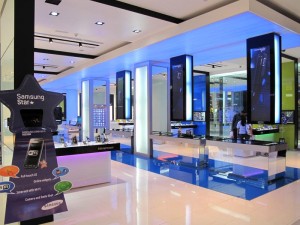Public spaces can have various uses for digital signage, but each of them has a slightly different environment where some features work better than others. For instance, a flashy digital screen might not be too thrilling in a library, meanwhile in a shopping mall it fits like a glove. We’ll see some features each of these locations share as well as some features useful for their optimal functionality.!
Wayfinding is the feature to talk about in public spaces. It typically refers to larger areas where people need help in finding the way to their destination, or simply get a grasp of their surroundings. It is one of the main uses of digital signage and it comes in various forms; for instance, it can be developed to assist users through their smartphones.
The presence of digital signage wayfinding is prevalent on a college campus or in a mall, but public spaces like zoos, museums and libraries are ideal candidates as well. For example, using wayfinding in a library can bring readers closer to Harry Potter’s goblet of fire or the process of photosynthesis without having to ask the information desk for directions each time. This lowers the pressure on the info desk and makes it easier for users to find what they’re looking for. A more detailed presence of wayfinding and other travelling information is usually found in public transport, but can be easily translated to indoor spaces.
Event management is a great opportunity to use digital signage to organize and guide the crowd at a local event or convention. This isn’t just a reference to wayfinding, but also keeping the visitors informed with up-to-minute information, showcasing event updates and news, as well as any changes in the schedule.
Digital signage in museums
When a guide isn’t present, or if a tour isn’t taking place, a series of digital displays can assist visitors and nudge them in the right direction. That’s wayfinding at its core. It can be interactive to enhance its effectivity. It ensures that the visitor will find exactly what he’s looking for in the shortest amount of time.
Museums are not only celebrated by the many historical items they contain and the knowledge they provide. The way of presenting certain knowledge is very important in today’s time, and advanced technologies ensure that knowledge is maintained and kept alive. Digital technology is not something you’d associate at the first thought with a museum which showcases mostly artefacts of the past, but times have changed.
A great example of the mix between digital signage and a museum is the olympic museum Lillehammer.
Digital signage in shopping malls
We’ve discussed retail in the past, but shopping malls as a whole are an entirely unique subject on their own. Aside from all the stores and shops, it is also a location where people gather casually. It is quite interesting that shopping malls in combination with digital signage provide engagement opportunities no other location can provide!
Engagement is a breeze for digital signage. In a shopping mall all the attention-drawing effects of a digital display are welcome, and this is yet another location where digital signage shines brightly.
Education and advertising go hand in hand as consumers like to be informed before they even consider making a purchase. On the educational side of things, a digital network provides an easy way to present all sorts of information, including local events, locations of interest, unique offers or it can even serve as a very effective emergency system.
With such a great platform as digital signage, there is still the question of benefit. Does the advertising in a shopping mall cover the expenses of digital signage?
This applies solely on the advertising aspect and not the other aspects such as directions and announcements. The business model of a mall relies on store rents more than on advertising. It is the center management responsibility to make shoppers spend as much time there as possible. They do this by creating a pleasant ambience!
As locations of interest, shopping malls have great potential in providing any form of information. The traffic in these locations means that with each display installed, the number of potential views rises significantly, and thus has great potential to influence the viewer’s purchasing decisions.
Digital signage in libraries
The perfect library environment is one of pure peacefulness, easy to fall asleep at. Should we admit, we all tried it at some point and of course failed? The truth is, just by sleeping on a book, we don’t instantly learn its content. The point is it’s just that quiet and calm: a factor which clashes with one of the main features of digital signage. Still, like any other piece in the education sphere, libraries are striving to enter the 21st century successfully.
Although digital signage is usually viewed as attention provoking – okay let’s be honest, it virtually shouts at the viewer – it tones down in a library environment, and uses other features to provide noteworthy benefits. In this case, people will approach a display with clear intention, as opposed to your classical digital signage in general where it draws the viewer in.
A great example of success in digital signage in a library environment can be seen at the University of California where a library environment blossomed from scratch, with proper guidance by its caretakers.
Now, let’s look into some key benefits of digital signage in a library.
A digital information desk is a great use of a display in an environment rich with information like lists, charts, fictional data, languages and authors: which all too often take about twenty minutes of searching before letting you know they are in the hands of another reader. On a serious note, an interactive digital display can answer frequently asked questions and it can also appeal to a broad demographic.
Upgrading the library to 21st century equipment is no small task, and here’s why. Let’s look at the factor of human nature for a moment. We are curious beings, and perhaps we’d like to browse different genres or selections of books. With a wayfinding display, for instance, it’s easier and more comfortable to obtain information, as opposed to asking directions for the 19th time. The display won’t frown and we won’t be ashamed of consulting again. If we’re interested in simply learning something new, a digital display containing an almost endless supply of data is the perfect place to start.
Event information is an excellent usage for any institution which serves as a community center. In the case of a library it’s group gatherings, author readings, book club meetings, discussions and similar events. It all depends on the environment, really, and if there is a decrease in such events, you can always indicate other local events which may appeal to the audience.
Digital signage lowers costs
You may have wondered why libraries don’t provide blankets and pillows for your afternoon nap at the section about tax codes. Jokingly, this may be because libraries operate on a limited budget and are often non-profit. Cost savers are essential, and digital signage can be a great cost saver as well as increase the income just by its presence. Yes, users will find what they’re looking for without a display, but as we’ve said at the very start, this is the 21st century and such things are appealing to society. There are many cases of libraries trying to achieve just that with digital signage.
A digital display network – well organized, of course – saves time, lowers the pressure and greases up the flow of information. In libraries, it makes librarians and readers more comfortable, but let’s talk about some finances you can see. Printing and the slow flow of data is eradicated if digital signage comes into play.
One of the main issues of written signage in public areas is that it’s ignored on a constant basis. It’s essentially become an unwritten rule to try your best to ignore the fliers and pictures you see hanging on any info boards, unless it’s a poster for a movie or something entertaining. The benefit of a digital display is that it provides an appealing platform where there’s no such thing as ignored data.
Summary
The many features of digital signage are shared amongst various public locations, but each of them have at least one unique benefit. It’s important to note that the environment has great influence over which features of digital signage will be of greater use to you, for instance the prevalent demographic plays a great part over the content displayed. With that in mind, we’ve seen some general benefits for public locations:
- Wayfinding is a useful and popular feature which is growing continuously. It is great for museums, community locations like a shopping mall, or even a library.
- A unique presentation tool makes the sharing of knowledge more comfortable and more interesting: the two vital components of any type of education.
- Libraries can be updated to modern institutions by the mere presence of a digital signage network. This is yet another location where information delivery can be greatly improved.
- The benefits of digital signage are clear for educational and public community purposes, but also for advertising in places like shopping malls.
A very important feature of digital signage in any establishment or location is the ability to cut off costs and maximize the perks. It’s a great platform for information sharing, and it’s now comfortable to make the transition to it. Digital signage is easy to use, easy to learn and eliminates the need for printing on paper – leave that to the authors!
Images by Lauren Manning and bu-hamad.








